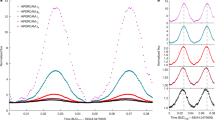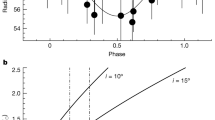Abstract
One suggested progenitor system for the 1.5–ms pulsar PSR1937+214 is a close binary containing, in the late stages of its evolution, a neutron star and a very-low-mass (≲0.1 M⊙) degenerate dwarf helium star1,2. The two main questions that affect the plausibility of this scenario are: (1) whether the system's evolution would in fact leave the neutron star at the observed high spin rate; and (2) whether the secondary could be disrupted, leaving a single pulsar. Here, we have analysed such a system using the predictions of Ghosh and Lamb3, and find that the equilibrium rotation period predicted for the neutron star immediately before the disruption of the secondary is so large that matter accreted from a disk after disruption would be unlikely to spin the pulsar up to the observed period. Furthermore, our estimate for the magnitude of tidal torques that transfer rotational angular momentum from an accretion disk back into the orbital motion may give values substantially higher than the previous estimate1;. It is thus unlikely that PSR1937+214 originated in a binary system in which the companion had an extremely low mass at disruption.
This is a preview of subscription content, access via your institution
Access options
Subscribe to this journal
Receive 51 print issues and online access
$199.00 per year
only $3.90 per issue
Buy this article
- Purchase on Springer Link
- Instant access to full article PDF
Prices may be subject to local taxes which are calculated during checkout
Similar content being viewed by others
References
Ruderman, M. A. & Shaham, J. Nature 304, 425–427 (1983).
Ruderman, M. A. & Shaham, J. Astrophys. J. 289, 244–246 (1985).
Ghosh, P. & Lamb, F. K. Astrophys. J. 234, 296–316 (1979).
Alpar, M. A., Cheng, A. F., Ruderman, M. A. & Shaham, J. Nature 300, 728–730 (1982).
Bonsema, P. F. J. & van den Heuvel, E. P. J. Astr. Astrophys. 146, L3–L5 (1985).
van den Heuvel, E. P. J. & Bonsema, P. T. J. Astr. Astrophys. 139, L16–L18 (1984).
Li, F. K., Joss, P. C., McClintock, J. E., Rappaport, S. & Wright, E. L. Astrophys. J. 240, 628–635 (1980).
Vila, S. C. Astrophys. J. 168, 217–223 (1971).
Taam, R. E. & Wade, R. A. Astrophys. J. 293, 504–507 (1985).
Henrichs, H. F. in Accretion-Driven Stellar X-ray Sources (eds Lewin, W. H. G. & van den Heuvel, E. P. J.) 393 (Cambridge University Press, 1983).
Shapiro, S. L. & Teukolsky, S. A. Black Holes, White Dwarfs and Neutron Stars (Wiley, New York, 1983).
Henrichs, H. F. & van den Heuvel, E. P. J. Nature 303, 213–215 (1983).
Hut, P. & Paczynski, B. Astrophys. J. 284, 675–684 (1984).
van den Heuvel, E. P. J. in Proc. Green Bank Workshop on Millisecond Pulsars (eds Reynolds, S. & Stinebring, D.) 86–103 (National Radio Astronomy Observatory, Green Bank, West Virginia, 1984).
Goldreich, P. & Tremaine, S. Astrophys. J. 233, 857–871 (1979).
Author information
Authors and Affiliations
Rights and permissions
About this article
Cite this article
Jeffrey, L. Feasibility of a low-mass binary source progenitor for PSR1937+214. Nature 319, 384–386 (1986). https://doi.org/10.1038/319384a0
Received:
Accepted:
Published:
Issue Date:
DOI: https://doi.org/10.1038/319384a0
This article is cited by
Comments
By submitting a comment you agree to abide by our Terms and Community Guidelines. If you find something abusive or that does not comply with our terms or guidelines please flag it as inappropriate.



